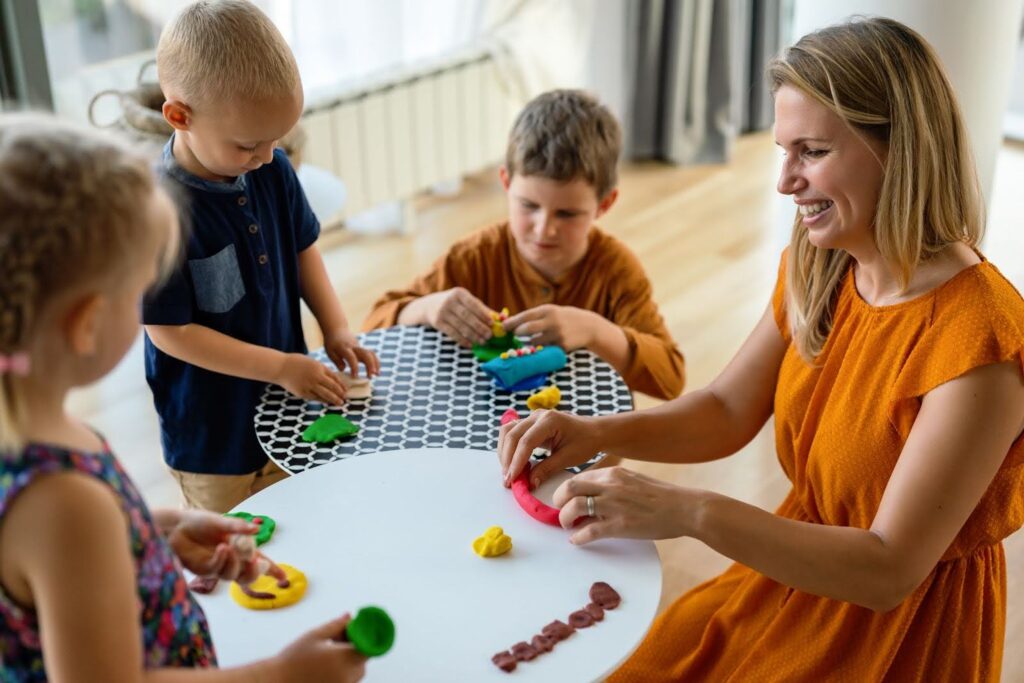
Children often carry burdens they can’t explain. They may act out, withdraw, or exhibit behaviors that leave parents confused and overwhelmed. Verbal questions like “What’s wrong?” can fall flat or even backfire. For many children, the words just don’t come. Healing begins when children express their inner world through play, not pressure.
What is Play Therapy and Why Does it Matter?
Play therapy is a specialized method that professionals use to help children express themselves. It relies on the idea that play is a child’s first language. Children reveal thoughts and feelings they may not yet understand through toys, games, and stories. The therapist uses these cues to support emotional growth and healing.
A Child’s Language When Words Don’t Work
Children experience big emotions long before they know how to name them. They might show fear through silence or anxiety through restlessness. Rather than say, “I’m sad,” a child might throw toys or cry without knowing why. Play allows children to express what’s happening inside without needing perfect words. It enables them to share their inner lives in a form they already understand.
H3: Defining Play Therapy in Practice
In a therapy room, children aren’t just “playing around.” Every toy is intentional, from dolls and blocks to puppets and drawing pads. These tools help therapists observe behavior, themes, and hidden struggles. Sessions often appear relaxed, but they follow a structured approach guided by clinical goals. The therapist carefully tracks progress, adapting to the child’s pace and needs.
How Play Therapy Differs from Regular Playtime
Playing at home is free and often directed by entertainment. Play therapy has a purpose woven into every interaction. Therapists set up spaces that reflect safety, boundaries, and openness. Children can take emotional risks because they know they won’t be judged or punished. That separates it from ordinary fun because it’s emotional work in disguise.
How Does Play Therapy Help Children Feel Better?
Many children can’t say why they’re upset or acting out. Instead, they show it through tantrums, withdrawal, or defiance. Play therapy helps them make sense of their feelings, one game at a time. It gently teaches them how to cope and rebuild emotional balance.
Helps Release Emotions Through Safe Expression
A child might re-enact a scary memory using toy soldiers or draw storms when they feel inner chaos. These actions let therapists see the patterns without forcing children to talk. The release of emotion comes naturally, not under pressure. Over time, children learn to identify and manage complicated feelings through symbolic play.
Helps Build a Relationship Based on Trust
Trust isn’t automatic, especially for children who have been hurt. A consistent and respectful therapist builds trust over time. Children test boundaries, express fears, and seek comfort during play. Each of these moments strengthens the emotional bond. When a child feels safe, they open up in meaningful, healing ways.
Strengthens Emotional and Cognitive Skills
While playing, children also develop their mental abilities. They learn patience by taking turns, problem-solving through puzzles, and empathy through pretend stories. These gains support school success and peer relationships. The therapist subtly guides these moments to align with therapeutic goals. Growth becomes a natural byproduct of playful interaction.
What Conditions Can Play Therapy Support?
Play therapy works well for many emotional and behavioral struggles. It adapts to each child’s age, personality, and lived experience. The approach remains effective whether the root is trauma, fear, stress, or change. It meets children where they are.
Coping With Trauma, Anxiety, and Stress
Children don’t process trauma like adults do. A dog bite, a car crash, or yelling at home can all leave lasting fear. These feelings may return as nightmares, sudden anger, or regression. Play therapy lets children process these memories without reliving the fear. They slowly reclaim a sense of control through storytelling and repetition.
Managing Behavioral Challenges
Some children seem angry, while others struggle to sit still or get into trouble. Play therapy offers tools to manage impulses and express frustration in a safe and healthy manner. Games and structured routines help create a sense of predictability. Children learn that their behavior can change, and so can their outcomes.
Navigating Divorce and Family Transitions
When families change, children often blame themselves. They may feel abandoned, confused, or powerless. Play therapy helps clarify these emotions safely. Kids might draw two houses or act out moving scenes with toys. Through this, they gain understanding and emotional closure.
Supporting Children on the Autism Spectrum
Children with autism often struggle with social communication and sensory input. Play therapy adapts to their comfort zones while gently encouraging the development of new skills. It might use visual schedules, soothing textures, or quiet spaces. These customizations help children engage on their terms. Over time, it supports social bonding and emotional insight.
What Happens During a Play Therapy Session?
Each session follows a rhythm designed for safety and growth. Children are welcomed into a familiar room with specific toys and tools. The therapist observes and sometimes participates. Nothing is rushed or forced, as each moment is built on a foundation of trust.
Inside a Typical Session
Children usually begin by choosing a toy or activity. Some may jump into role-play, while others build or draw. The therapist watches closely, taking note of patterns or themes. Depending on the approach, they may ask questions or mirror the child’s play. Sessions close with a calming ritual or check-out to facilitate a smooth transition.
Different Approaches to Play Therapy
Not every therapist uses the same method. Non-directive play therapy allows the child to lead, while directive therapy offers specific goals and tasks. Some use cognitive-behavioral techniques combined with play. Others may include storytelling, sand play, or expressive art. Each approach depends on the child’s needs and the therapist’s training.
The Parents’ Role in the Process
Parents aren’t left out, but are an integral part of the healing journey. Therapists meet with caregivers before, during, and after treatment. They offer insights, coaching, and sometimes homework to reinforce progress. However, they don’t force information or demand results. The goal is understanding, not blame.

How Long Does Play Therapy Usually Last?
Therapy isn’t a one-time fix; it’s a process. Some children show growth within weeks, while others need several months. The pace depends on the depth of the challenge and the child’s readiness. Consistency matters more than speed.
Timing Depends on the Child, Not the Clock
Some children may need just eight to twelve sessions to feel relief, while others with deeper wounds may require ongoing support. Progress is tracked through changes in behavior, mood, and communication. Sessions may adjust over time, becoming less frequent as confidence builds. Therapy ends when goals are met and the child feels strong again.
How to Know if Your Child Needs Play Therapy
Parents often sense that something is wrong before anyone else does. Changes in behavior, mood, or social life may be early signals. If something feels “off” and doesn’t pass, it might be time to seek professional help. Play therapy offers a low-pressure first step.
Emotional and Behavioral Warning Signs
A child might suddenly stop talking at school or become unusually clingy. Others may start wetting the bed or engaging in fights without apparent reason. These behaviors may indicate emotional overload, rather than bad behavior. Watch for persistent patterns that don’t improve with time. Trust your instincts, as they’re often ahead of the curve.
When Traditional Discipline Doesn’t Work
If rewards and punishments fail, the issue may be more complex. The child could be reacting to stress they don’t understand. In those cases, emotional support is more effective than control. A play therapist helps decode the behavior and shift it at the root, saving families from constant conflict.
What Makes Play Therapy Different from Other Therapies?
Play therapy stands apart because it meets children at their developmental level. Unlike other approaches that rely heavily on verbal reflection or behavioral conditioning, play therapy works through experience. It creates a bridge between emotion and action that children can cross. Understanding these differences helps parents make informed choices.
Play Therapy vs. Talk Therapy for Children
Traditional talk therapy often depends on a client’s ability to reflect and verbalize, which works well for teens and adults, but not for young children. Kids may not yet have the language or insight to explain their feelings. Play therapy bypasses that limitation by using their natural form of communication. The result is therapy that feels intuitive and safe, rather than forced or frustrating.
Play Therapy vs. Behavior Management Programs
Some parents are referred to behavior programs that focus on outcomes such as stopping hitting, following rules, and sitting still. These systems may temporarily alleviate symptoms, but they often overlook the root cause. Play therapy addresses the emotional reasons behind the behavior. A child who throws chairs may be overwhelmed, not disobedient. Play therapy creates lasting change by helping children process what drives their actions.
How Play Therapy Aligns With Brain Development
Play therapy doesn’t just aim to make kids feel good; it works in sync with the way young brains develop. During childhood, the brain forms emotional templates and coping patterns. Play activates the brain’s natural learning systems in a safe and structured way, making the approach both gentle and powerful.
The Neuroscience of Play and Emotional Safety
Neuroscience reveals that play activates areas of the brain associated with emotion regulation, social skills, and memory. When children feel safe, their brains release oxytocin and reduce cortisol. It opens the door for emotional exploration and learning. Play therapy taps into that state, helping the brain “rewire” through experience. It’s not just pretend; it’s practice for real life.
Sensitive Periods and Emotional Rewiring
Childhood is filled with windows of opportunity —times when the brain is especially receptive to change. These “sensitive periods” are ideal for forming emotional habits. Play therapy uses this flexibility to help children build new responses to fear, anger, or sadness. Instead of storing stress in silence, they learn to express and manage it. That change can shape their emotional future in meaningful ways.
What is Play Therapy’s Long-Term Impact?
Healing doesn’t end when therapy comes to a close. Children often carry the benefits into school, relationships, and future challenges. Play therapy helps them build inner tools they’ll use for years. It’s not just a fix; it’s a foundation. Children who complete therapy often exhibit calmer responses and clearer boundaries. They express emotions more clearly and handle change more easily. These skills continue to develop as they grow. Many parents report stronger relationships and fewer outbursts. That’s real, lasting change.
Make Room for Growth Through Play Therapy
Growth doesn’t happen in silence; it needs space, safety, and connection. When children can’t express their feelings, they often show them in ways that can go unnoticed. Play therapy creates a space where that confusion turns into understanding. Give your child that room before the hurt becomes harder to reach.
Get trusted support from the Moving Forward PLC blog. Join our newsletter for fresh tips and resources delivered to you.
